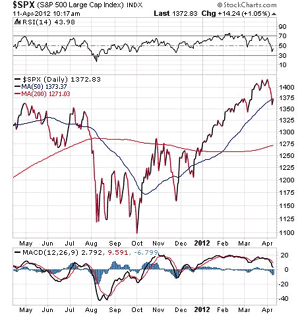April showers may bring May flowers, but in the market the rains have dampened investors enthusiasm from the nice first-quarter rally, observes Doug Fabian of Making Money Alert.
The equity markets are down so far in April. Yes, you read that right; stocks have finally shown that they do, in fact, sell off from time to time. The major indices recently suffered their first five-day losing streak in what seems like forever. The selling definitely is the first substantive pullback in stocks since the beginning of the year.
The April stock showers have come largely as a result of last month's pitiful jobs report, which came in well below expectations. The light employment growth data shows that the real economy in the United States still is far from healthy. I’ve said in the past that until we get more Americans back to work and making money, we are going to have a hard time seeing a sustainable recovery in the economy, the housing market—and even the stock market.
In addition to the poor reading on the March employment front, trouble in Europe is really starting to rear its ugly head. Renewed fears heated up earlier this month with the poor showing in the Spanish bond auction that saw the country sell only €2.3 billion worth of four- to eight-year debt at yields sharply higher than previous auctions. Spanish bond yields are still well above 5.5%, and that situation is not good news for that country’s economy, or for the European Union.
During the past several months, I’ve been warning you about Europe, and about the precarious nature of the region’s debt issues. Could Europe’s fiscal chickens finally be coming home to roost?
I suspect the better analogy is that investors here in the United States and around the globe finally are waking up to the fact that things aren’t all that great economically—either in Europe, or here at home.
Technically speaking, the S&P 500 Index has experienced its first dip below the 50-day moving average since last year. The chart below shows the sharp drop that’s occurred in stocks since the April showers began. Of course, that drop also has come after a near-relentless rise in stocks since December.
When it comes to stocks in the international sphere, the technical damage is much more pronounced. If we look at the chart below of the iShares MSCI EAFE Index (EFA), a benchmark for international equities, we see that not only has the index fallen below its 50-day moving average, it also has sunk below its 200-day average for the first time since last August. Note that when the 200-day average was breached in August, it was followed by a pronounced drop in the index's value.
That drop happened as a result of Europe’s debt woes heating up, and that same scenario could be unfolding right now. I think the European debt mess is coming to a head, and now even the mainstream media is getting worried.
Last Sunday’s telling 60 Minutes television news report explained the extent of the European debt problem and its potentially devastating effect on the European Union’s political and fiscal stability. The report was just another sign that the situation now has reached almost everyone’s radar.
A new exchange traded fund (ETF) that has gained my attention for the dual way it can help you profit is the iShares Morningstar Multi-Asset Income Index Fund (IYLD). The fund specifically seeks to replicate the Morningstar Multi-Asset High Income Index, a broadly diversified index that aims to deliver high current income and long-term capital appreciation.
The fund offers a way to protect your money from the full force of a sustained market retreat due to its payment of a dividend. However, the fund only began trading on April 3, so it has not paid a dividend yet, and thus has little track record to share with you.
In addition, the fund’s trading volume is too light for me to consider recommending it at this time. However, the trading volume should increase quickly as the fund becomes better known. As a result, it definitely is worth watching.
The index that this fund is designed to track consists of a comprehensive set of iShares ETFs that collectively target equity, fixed income and alternative income sources. The fund’s composition is weighted toward bonds, roughly 55%, but also includes a significant percentage of equities, approximately 20%.
Specifically, the holdings on April 9 featured: domestic fixed income, 45.31%; cash and collateral, 25.32%; domestic equities, 14.85%; international fixed income, 9.68%; and international equities, 4.84%.
The top five holdings in IYLD, also as of April 9, were: iShares IBoxx Corporate Bond Fund (HYG), 19.56%; iShares Barclays 20+ Year Treasury Fund (TLT), 15.38%; iShares S&P Preferred Stock Index Fund (PFF), 14.85%; iShares Dow Jones Select Dividend Index Fund (DVY), 14.80%; and iShares IBoxx Investment Grade Corporate Bond Fund (LQD), 10.37%. Those funds are some of the largest and best known offered by iShares.
Subscribe to Making Money Alert here...
Related Reading:
7 ETFs for Givers, Bears, and Others












